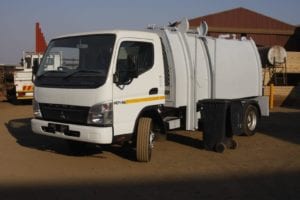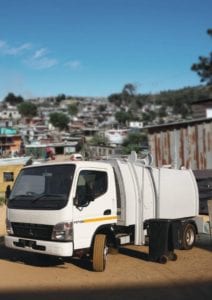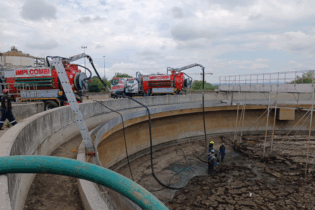
Skip Truck Traders’ new mini compactor is a side-loader where 240 ℓ wheelie bins are lifted and tipped into an opening at the top of the vehicle
Affordable price
A standard REL will typically cost about R2 million. Skip Truck Traders’ new four-tonne mini compactor costs in the region of R650 000 (including truck), meaning that municipalities can purchase three small vehicles at the same cost as a single large truck. “The vehicle’s smaller size results in other cost savings as well – these include a two-thirds saving on running costs; smaller and more affordable tyres; a reduced fuel bill; and lower maintenance costs,” says Edwards.The compactor also comes with the same standard guarantee on all of Skip Truck Traders’ vehicles: “If it breaks down within the first 12 months, we will provide a replacement rental vehicle free of charge for the period that it takes for us to do the required repairs.”
Design features
In some places, like the Johannesburg CBD, street sweepers still use plastic bags to collect waste. For this reason, Skip Truck Traders’ mini compactor is designed with side-doors for street cleaners’ waste. The vehicle could also be used in municipal separation-at-source initiatives, where different waste streams – such as green waste – could be collected and then dropped off at a separate facility not situated at the main landfill. “One of the design features of the unit is that it does not fully compact the waste, because that would cause it to exceed the vehicles maximum loading capacity. This is calculated based on general waste. Most recyclables are much lighter like plastic bags that can be compacted for optimal loading,” says Edwards. The mini compactor’s rear is about an inch lower than the rear of a standard REL. To overcome the height difference, a small hydraulic cylinder has been installed to lift the body by about 300 mm, ensuring that the clearances between the two vehicles can be aligned so that waste can be easily transferred from one to the other.Local manufacturing
The truck’s lifting system is an all-South African design. “The mini compactor is made in South Africa for Africa,” says Edwards. Skip Truck Traders has also expanded to begin manufacturing its own cylinders. “We recently purchased a range of fully automated CNC lathes, which produce 100% accurate cylinders to our exact specifications,” he concludes. www.skiptrucktraders.co.zaHighlights
- Designed for waste collection in informal settlements and housing estates
- Purchase price is around one-third the price of a regular compactor
- Lower running and maintenance costs
- Can be used for separation-at-source
- No fleet downtime when used in conjunction with a standard REL compactors
- Aligns the clearance distance between mini and standard compactors for ease of waste transfer
Skip Truck Traders









